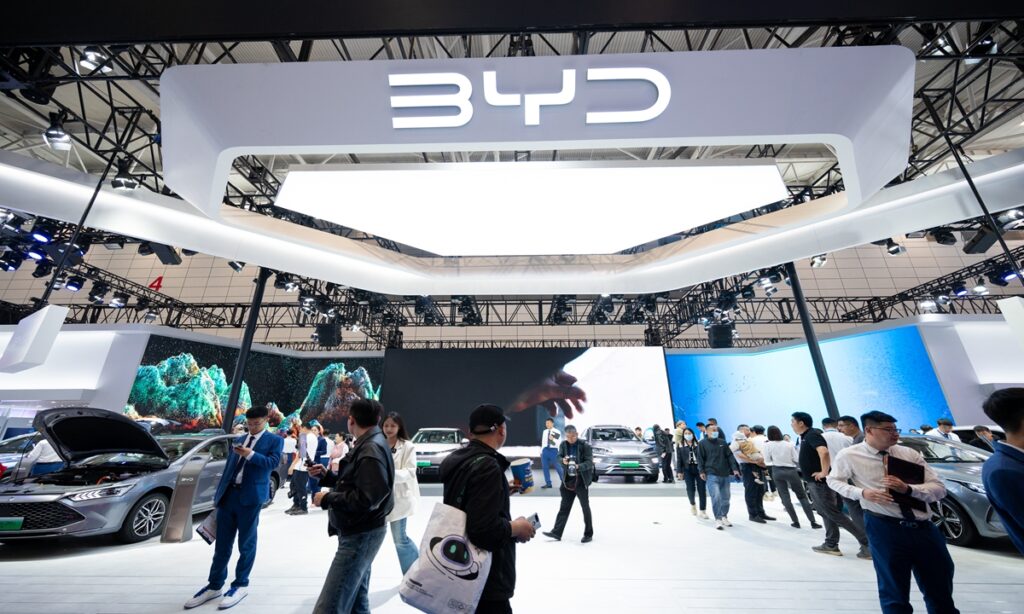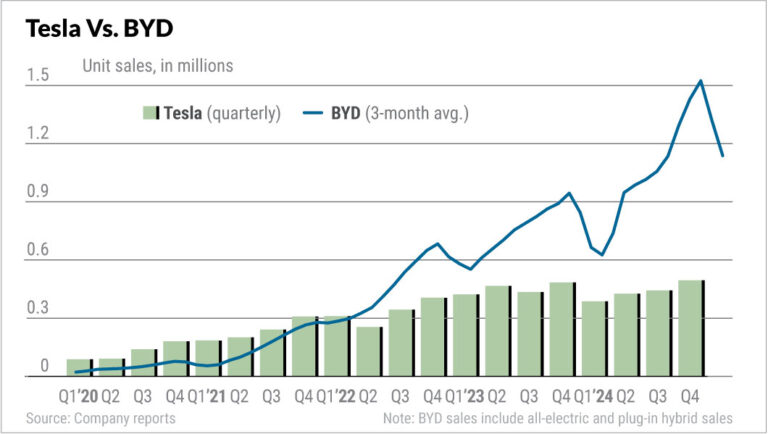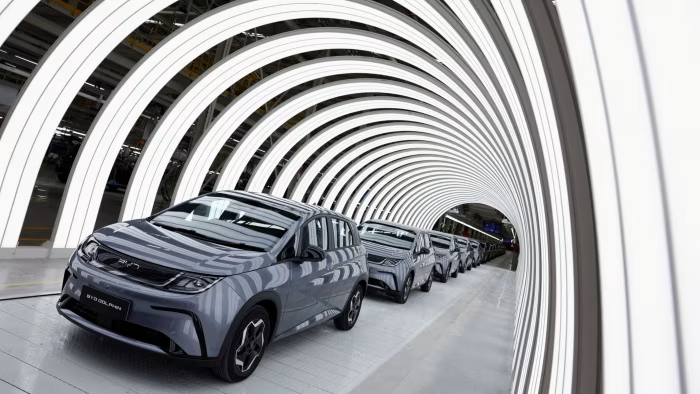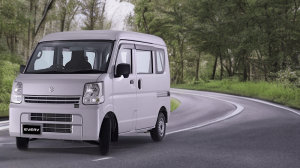ISLAMABAD, March 14: With an exorbitant sale of 4.25 million units globally in 2024, BYD, the largest Chinese electric automaker, is expected to touch 5.5 million vehicle sale in 2025, outstripping the pace of Tesla, the US EVs automaker.
BYD has set targets for itself, of around 5-6 million electric vehicles sale globally.
From China, BYD exported 417,204 vehicles in 2024, registering a huge 71.9% jump from 2023. The company sold 3.49 million vehicles in China, of around $58 billion.
BYD’s record-breaking sales and market growth in 2024 highlight its strong position in the global automotive and energy sectors, setting the stage for continued success in 2025.
2025 Outlook:
- Analysts predict that BYD will sell around 5.5 million cars in 2025.
- The anticipated higher volumes are expected to reduce unit costs, improving margins per vehicle.
- BYD has set a target to sell between 5 million and 6 million cars in 2025.
2024 Sales Overview and Comparison:
Global Sales:
In 2024, BYD set a record by selling 4.25 million vehicles globally, marking a 41% increase from 2023.Sales in China:
The company sold 3.49 million vehicles in China, generating revenue of 420.7 billion yuan (around $58 billion).Exports:
BYD exported 417,204 vehicles in 2024, reflecting a significant 71.9% increase from 2023. Exports accounted for about 10% of the company’s total sales.Market Position:
BYD surpassed Volkswagen and SAIC in October 2024, becoming the largest automaker in China. It also ranked first in car sales revenue in China, surpassing both Mercedes-Benz and Volkswagen.New Energy Vehicles (NEVs):
BYD sold a total of 4.27 million NEVs in 2024, which includes both battery electric vehicles (BEVs) and plug-in hybrid electric vehicles (PHEVs), marking a growth of about 41.26% compared to the previous year.BEV and PHEV Sales:
- BEV sales rose by 12.08%, totaling 1.76 million vehicles in 2024.
- PHEV sales soared 72.83% year-on-year to reach 2.49 million units.
Average Selling Price (ASP):
BYD’s average selling price per vehicle was $16,700 (121,000 yuan), much lower compared to Mercedes-Benz’s $59,500 (430,000 yuan) and Volkswagen’s $19,700 (143,000 yuan).
Read More: BYD Sea Lion 07 Market price in Pakistan
Key Achievements in December 2024:
Monthly Sales:
BYD achieved a new milestone in December with 514,809 NEV sales, bringing the total for the year to 4.27 million units, a 41.3% increase over 2023.Passenger BEVs and PHEVs:
- 1.76 million BEVs were sold, a 12% increase compared to 2023.
- 2.49 million PHEVs were sold, up 72.8% from the previous year.
Production Shift:
Since April 2022, BYD has ceased the production of internal combustion engine (ICE) vehicles and now focuses exclusively on new energy vehicles, including BEVs, PHEVs, and fuel cell electric vehicles (FCEVs). However, FCEV sales remain minimal in China.December Sales Performance:
In December, BYD sold 509,440 passenger vehicles, a 49.8% year-on-year increase. This also marked the third consecutive month in which BYD exceeded 500,000 passenger vehicle sales.Commercial Vehicles:
Commercial vehicle sales surged 520% in December, totaling 5,369 units. BYD sold 21,775 commercial vehicles throughout 2024.Export Growth:
BYD exported 57,154 vehicles in December, a 58% increase from the previous year. For the full year, exports reached 417,204 units, marking a 71.9% increase from 2023.

Battery and Energy Storage:
Battery Supply:
BYD is also a leading supplier of batteries in China, ranking as the second-largest supplier. Its customers include major EV brands like Tesla, Nio, and Toyota.Battery Installations:
In December, BYD installed 23.5 GWh of battery capacity, a 32% increase compared to the previous year. For 2024, the company installed a total of 194.7 GWh, up 29% from 2023, covering both EV and stationary energy storage.
Tesla vs BYD Sold Unit
In 2022, BYD, the Chinese EV and battery giant, surpassed Tesla in vehicle sales, and by Q4 2024, its sales were more than three times higher than Tesla’s. While BYD claimed the lead in battery-electric vehicle (BEV) sales for Q4, Tesla still held a narrow edge for the full year of 2024.
Read More: BYD Tang 2025 Price in Pakistan
Both Tesla and BYD set new quarterly delivery records in Q4, but Tesla experienced a drop in annual deliveries for the first time. Despite benefiting from a Bitcoin windfall, Tesla’s earnings came in lower than expected.
Tesla’s stock soared in late 2024 as investors pinned hopes on Full Self-Driving, robotics, and AI, with speculations that the incoming Trump administration would support Elon Musk’s ventures.
However, Tesla stock has recently seen a sharp decline due to concerns over potential delays in self-driving technology and worries that Musk’s political involvement could hurt the brand’s reputation and, consequently, its sales.
Deliveries of the new Model Y began, which should help support Tesla’s sales in 2025. Meanwhile, BYD has surged to record levels, especially as the company pushes forward with integrating autonomous driving technology into its lineup, including vehicles as affordable as $10,000. BYD’s sales have had a strong start in 2025.
Tesla vs. BYD Sales
In Q4, Tesla delivered 495,570 EVs, a slight increase from 462,890 in Q3, surpassing its previous Q4 record of 484,507 in 2023.
However, this fell short of the expected 506,000 deliveries and the company’s guidance of 515,000, despite aggressive discounts and incentives toward the end of the year.
Tesla’s reliance on China sales, which typically yield lower profit margins, grew in Q4.
Also Read: BYD Shark 6 Price in Pakistan
Deliveries of the Cybertruck appeared to slow in Q4, despite the price cut to $79,990 with the launch of the non-Foundation series.
The dual-motor Cybertruck, eligible for the $7,500 tax credit starting January 1, could see a short-term boost in demand. However, Tesla might be operating at a loss on the new Cybertruck at its lowered price.
For the full year, Tesla delivered 1,789,226 vehicles, down slightly (1%) from 2023’s 1,808,591.
On a more positive note, Tesla deployed 11 gigawatt-hours of energy storage products in Q4, setting a new record and bringing its total for the year to 31.4 GWh.
On the other hand, BYD achieved a major milestone, selling a record 1,524,270 vehicles in Q4—an increase of 61% from the previous year and more than triple Tesla’s total. For the entire year, BYD’s sales rose 41% to 4,272,145 units.

Plug-in hybrids led BYD’s 2024 sales, largely due to the company’s new, long-range hybrid models. However, BYD still sold 595,413 passenger BEVs in Q4, surpassing Tesla’s BEV sales by approximately 100,000 units. For the year, BYD’s BEV sales totaled 1,764,992, just shy of Tesla’s total.
In January 2025, BYD sold 300,358 vehicles, a 49% increase year-over-year, though it was a 42% drop compared to the record December sales.
In February, BYD’s sales surged to 322,846, a 164% increase year-over-year, and 7.4% higher than January’s pace.
Also Read: BYD Qin Plus Price in Pakistan
While China’s auto sales have been sluggish due to the Lunar New Year holidays, activity is expected to pick up in the spring.
Though Tesla may reclaim the BEV sales crown in Q1 2025, it has started the year with weak sales.
Tesla and BYD War
In each of the 10 markets where both Tesla and the Chinese automaker BYD list prices online, BYD’s entry-level models are priced lower than Tesla’s.
While Tesla primarily focuses its sales in North America and Europe, BYD is expanding rapidly in regions such as Latin America and Southeast Asia.
The year 2024 was pivotal for BYD, as it solidified its position as the world’s largest electrified vehicle manufacturer.
For the first time, it surpassed Tesla in revenue in Q3 2024 and in the number of fully electric vehicles delivered in Q4.
BYD is particularly competitive against Tesla in non-Western countries, where Tesla has a smaller presence and BYD undercuts its American rival on pricing.
A recent analysis of prices in 10 non-Western countries, including Mexico, Chile, the UAE, China, Hong Kong, South Korea, Japan, Thailand, Malaysia, and Singapore, reveals that BYD’s cheapest models are more affordable than Tesla’s Model 3, which is the lowest-cost offering in all these regions.









